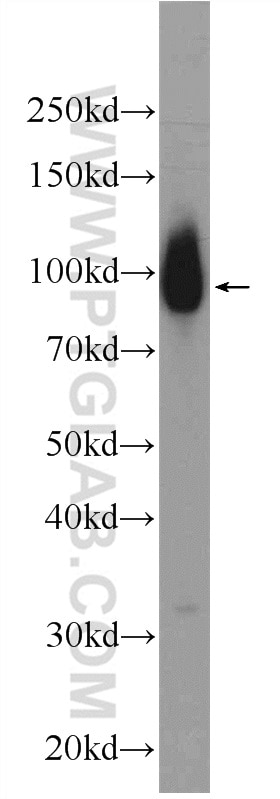- Featured Product
- KD/KO Validated
E2F7 Polyklonaler Antikörper
E2F7 Polyklonal Antikörper für WB, ELISA
Wirt / Isotyp
Kaninchen / IgG
Getestete Reaktivität
human und mehr (1)
Anwendung
WB, IHC, IF, CoIP, ELISA
Konjugation
Unkonjugiert
Kat-Nr. : 24489-1-AP
Synonyme
Galerie der Validierungsdaten
Geprüfte Anwendungen
| Erfolgreiche Detektion in WB | HeLa-Zellen |
Empfohlene Verdünnung
| Anwendung | Verdünnung |
|---|---|
| Western Blot (WB) | WB : 1:500-1:1000 |
| It is recommended that this reagent should be titrated in each testing system to obtain optimal results. | |
| Sample-dependent, check data in validation data gallery | |
Veröffentlichte Anwendungen
| KD/KO | See 2 publications below |
| WB | See 11 publications below |
| IHC | See 2 publications below |
| IF | See 3 publications below |
| CoIP | See 1 publications below |
Produktinformation
24489-1-AP bindet in WB, IHC, IF, CoIP, ELISA E2F7 und zeigt Reaktivität mit human
| Getestete Reaktivität | human |
| In Publikationen genannte Reaktivität | human, Maus |
| Wirt / Isotyp | Kaninchen / IgG |
| Klonalität | Polyklonal |
| Typ | Antikörper |
| Immunogen | E2F7 fusion protein Ag21599 |
| Vollständiger Name | E2F transcription factor 7 |
| Berechnetes Molekulargewicht | 911 aa, 100 kDa |
| Beobachtetes Molekulargewicht | 95 kDa |
| GenBank-Zugangsnummer | BC136366 |
| Gene symbol | E2F7 |
| Gene ID (NCBI) | 144455 |
| Konjugation | Unkonjugiert |
| Form | Liquid |
| Reinigungsmethode | Antigen-Affinitätsreinigung |
| Lagerungspuffer | PBS mit 0.02% Natriumazid und 50% Glycerin pH 7.3. |
| Lagerungsbedingungen | Bei -20°C lagern. Nach dem Versand ein Jahr lang stabil Aliquotieren ist bei -20oC Lagerung nicht notwendig. 20ul Größen enthalten 0,1% BSA. |
Hintergrundinformationen
E2F7 also named as E2F transcription factor 7 is a 911 amino acid protein, which belongs to the E2F/DP family. E2F7 localizes in the nucleus and mainly forms homodimers and, to a lesser extent, heterodimers with E2F8. E2F7 as a transcription factor involves in various processes such as angiogenesis, polyploidization of specialized cells and DNA damage response. E2F7 mainly forms homodimers and to a lesser extent, heterodimers with E2F8. (PMID: 18194653 )
Protokolle
| Produktspezifische Protokolle | |
|---|---|
| WB protocol for E2F7 antibody 24489-1-AP | Protokoll herunterladen |
| Standard-Protokolle | |
|---|---|
| Klicken Sie hier, um unsere Standardprotokolle anzuzeigen |
Publikationen
| Species | Application | Title |
|---|---|---|
Cell Death Dis Functional interplay between E2F7 and ribosomal rRNA gene transcription regulates protein synthesis. | ||
Oncotarget The synthetic antihyperlipidemic drug potassium piperate selectively kills breast cancer cells through inhibiting G1-S-phase transition and inducing apoptosis. | ||
Cancer Cell Int E2F1/2/7/8 as independent indicators of survival in patients with cervical squamous cell carcinoma.
| ||
Transl Oncol Comprehensive analysis to identify the RP11-478C19.2/ E2F7 axis as a novel biomarker for treatment decisions in clear cell renal cell carcinoma
|
Rezensionen
The reviews below have been submitted by verified Proteintech customers who received an incentive forproviding their feedback.
FH Umut (Verified Customer) (10-26-2023) | I could not get any signal in the U87 cells.
|
FH Ekaitz (Verified Customer) (05-03-2023) | We have tested this antibody for Chromatin Immunoprecipitation (ChIP) and it showed similar or even higher efficiency than the Santa Cruz antibody (sc-66870) that we have been using until now in the lab.
|
FH Shatovisha (Verified Customer) (12-06-2018) | This antibody always produced two non-specific bands at 40kD and one at 160kD, but could never get the correct sized band with several optimizations and antibody dilutions.
|


